2.2.2: Similar Polygons
- Page ID
- 35699
Lesson
Let's look at sides and angles of similar polygons
Exercise \(\PageIndex{1}\): All, Some, None: Congruence and Similarity
Choose whether each of the statements is true in all cases, in some cases, or in no cases.
- If two figures are congruent, then they are similar.
- If two figures are similar, then they are congruent.
- If an angle is dilated with the center of dilation at its vertex, the angle measure may change.
Exercise \(\PageIndex{2}\): Are They Similar?
1.
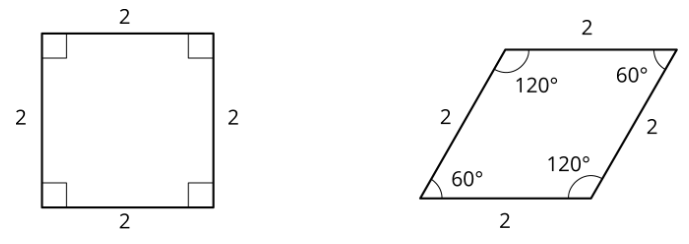
Let’s look at a square and a rhombus.
Priya says, “These polygons are similar because their side lengths are all the same.” Clare says, “These polygons are not similar because the angles are different.” Do you agree with either Priya or Clare? Explain your reasoning.
2. Now let's look at rectangles \(ABCD\) and \(EFGH\).
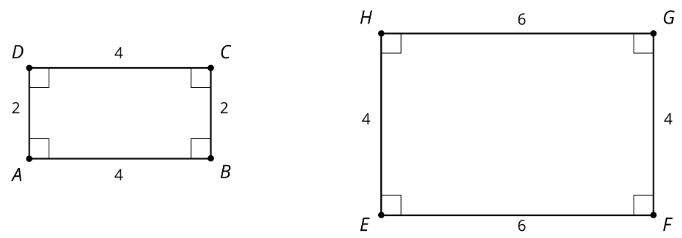
Jada says, “These rectangles are similar because all of the side lengths differ by 2.” Lin says, “These rectangles are similar. I can dilate \(AD\) and \(BC\) using a scale factor of 2 and \(AB\) and \(CD\) using a scale factor of 1.5 to make the rectangles congruent. Then I can use a translation to line up the rectangles.” Do you agree with either Jada or Lin? Explain your reasoning.
Are you ready for more?
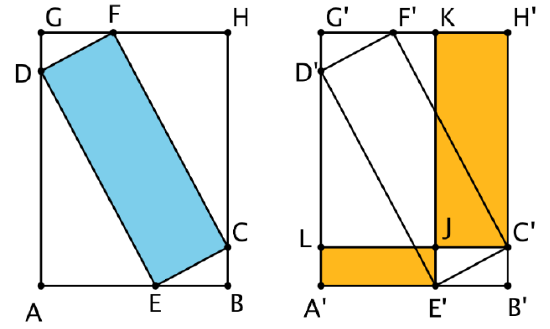
Points \(A\) through \(H\) are translated to the right to create points \(A'\) through \(H'\). All of the following are rectangles: \(GHBA\), \(FCED\), \(KH'C'J\), and \(LJE'A'\). Which is greater, the area of blue rectangle \(DFCE\) or the total area of yellow rectangles \(KH'C'J\) and \(LJE'A'\)?
Exercise \(\PageIndex{3}\): Find Someone Similar
Your teacher will give you a card. Find someone else in the room who has a card with a polygon that is similar but not congruent to yours. When you have found your partner, work with them to explain how you know that the two polygons are similar.
Are you ready for more?
On the left is an equilateral triangle where dashed lines have been added, showing how you can partition an equilateral triangle into smaller similar triangles.
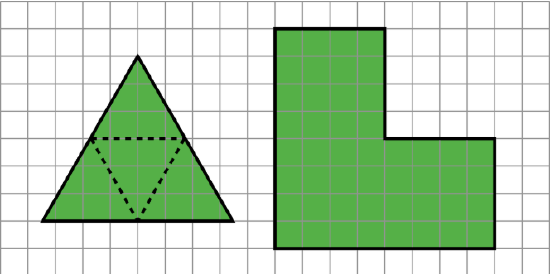
Find a way to do this for the figure on the right, partitioning it into smaller figures which are each similar to that original shape. What’s the fewest number of pieces you can use? The most?
Summary
When two polygons are similar:
- Every angle and side in one polygon has a corresponding part in the other polygon.
- All pairs of corresponding angles have the same measure.
- Corresponding sides are related by a single scale factor. Each side length in one figure is multiplied by the scale factor to get the corresponding side length in the other figure.
Consider the two rectangles shown here. Are they similar?
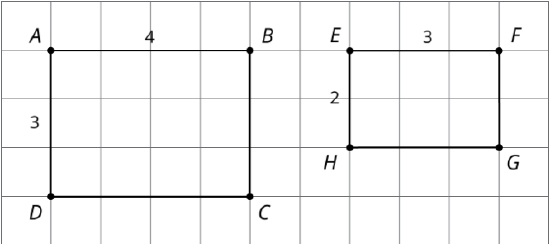
It looks like rectangles \(ABCD\) and \(EFGH\) could be similar, if you match the long edges and match the short edges. All the corresponding angles are congruent because they are all right angles. Calculating the scale factor between the sides is where we see that “looks like” isn’t enough to make them similar. To scale the long side \(AB\) to the long side \(EF\), the scale factor must be \(\frac{3}{4}\), because \(4\cdot\frac{3}{4}=3\). But the scale factor to match \(AD\) to \(EH\) has to be \(\frac{2}{3}\), because \(3\cdot\frac{2}{3}=2\). So, the rectangles are not similar because the scale factors for all the parts must be the same.
Here is an example that shows how sides can correspond (with a scale factor of 1), but the quadrilaterals are not similar because the angles don’t have the same measure:

Glossary Entries
Definition: Similar
Two figures are similar if one can fit exactly over the other after rigid transformations and dilations.
In this figure, triangle \(ABC\) is similar to triangle \(DEF\).
If \(ABC\) is rotated around point \(B\) and then dilated with center point \(O\), then it will fit exactly over \(DEF\). This means that they are similar.
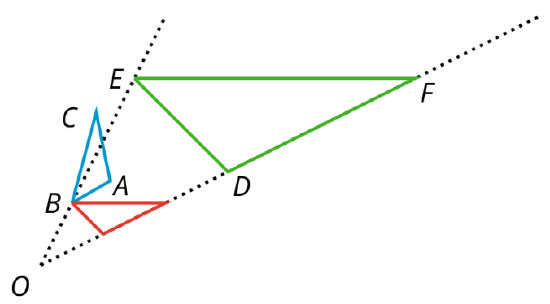
Practice
Exercise \(\PageIndex{4}\)
Triangle \(DEF\) is a dilation of triangle \(ABC\) with scale factor 2. In triangle \(ABC\), the largest angle measures \(82^{\circ}\). What is the largest angle measure in triangle \(DEF\)?
- \(41^{\circ}\)
- \(82^{\circ}\)
- \(123^{\circ}\)
- \(164^{\circ}\)
Exercise \(\PageIndex{5}\)
Draw two polygons that are similar but could be mistaken for not being similar. Explain why they are similar.
Exercise \(\PageIndex{6}\)
Draw two polygons that are not similar but could be mistaken for being similar. Explain why they are not similar.
Exercise \(\PageIndex{7}\)
These two triangles are similar. Find side lengths \(a\) and \(b\). Note: the two figures are not drawn to scale.
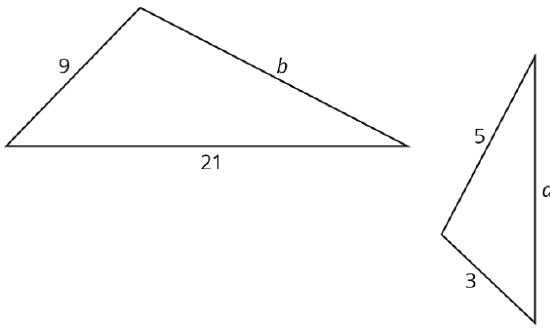
Exercise \(\PageIndex{8}\)
Jada claims that \(B'C'D'\) is a dilation of \(BCD\) using \(A\) as the center of dilation.
What are some ways you can convince Jada that her claim is not true?
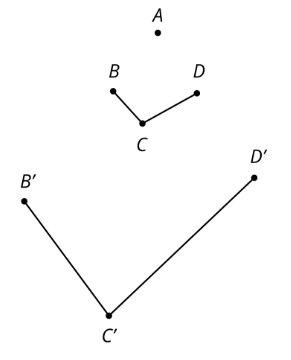
(From Unit 2.1.3)
Exercise \(\PageIndex{9}\)
- Draw a horizontal line segment \(AB\).
- Rotate segment \(AB 90^{\circ}\) counterclockwise around point \(A\). Label any new points.
- Rotate segment \(AB 90^{\circ}\) clockwise around point \(B\). Label any new points.
- Describe a transformation on segment \(AB\) you could use to finish building a square.
(From Unit 1.2.2)


